If you’re tiring of the Hawaiian Poke craze but love a bowl of raw fish, you might want to look to another island for inspiration.
Fijian Kokoda is very similar to a ceviche and offers a new take on the raw fish salad concept found throughout the Pacific Islands from Tahiti to Hawaii and all the way to South America.
If you love raw foods and believe in the idea of a raw food diet, definitely check out our other recipe on bircher muesli oats with fruits. You will also find information there about the grandfather of the raw food movement.

FOOD FROM THE ANCIENT ARCHIPELAGOS
As a recipe that doesn’t require much more than a knife, kokoda is the seminal desert island dish.
Pre-colonial histories of the Pacific Islands are scant since no written record was kept prior to the arrival of European explorers. What we do know is that the first islands – Papua New Guinea and Australia – were settled 33,000 years ago. From then on, the settlers slowly spread out to explore the more than 10,000 other small islands in the Pacific, and Fiji got its first inhabitants around 3,500 years ago.
We also know that these settlers were first-class fishermen capable of traveling frequently between the archipelagos. This was all made possible when our shrewd sailors invented an ingenious double-hulled sailboat that could transport them from one semi-submerged volcano to the next, thereby enabling intra-island contact and local trade.
YOU SAY KOKODA, I SAY IKA MATA
Evidence of these voyages can be seen on the menu. What’s called Kokoda in Fiji is known as Ika Mata in the Cook Islands, Oka in Samoa and Poke in Hawaii. Of course, there’s also no escaping the similarity to South American ceviche. All these dishes involve cutting the raw fish into cubes and marinating it in citric acid before mixing with a handful of other ingredients, like chopped onions, cucumbers or tomatoes.
For Fiji’s original inhabitants, fish along the coast were plentiful, and it was easiest to dice up the day’s catch into a bowl with a squeeze of juice from a local pockmarked rough lemon.
When life gives you lemons, make lemonade, but when your island in the middle of the Pacific Ocean gives you lemons, fish and coconuts… make kokoda.
ABOUT THE RECIPE
According to Robert Oliver, the Australian celebrity chef originally raised in Fiji, kokoda would have traditionally been made with ‘walu’ – Spanish Mackerel – marinated in a mixture of lime juice, chillies, onions and seawater. Today, the seawater is a less common ingredient whereas adding coconut milk to the dish has become a staple, a vital adjustment to the recipe that Chef Oliver attributes to a restaurateur in Suva around the 1930s.
MAHI MAHI
Sadly, Fijian fish are not as plentiful nowadays as they once were. The waters have been over-fished and polluted, and the added run-offs from soil erosion have produced a crisis in Fijian fisheries. Nesting turtle numbers have plummeted, and other fish have become extinct, including the bumphead parrotfish and two species of giant clams. Mahi Mahi is, however, still in relative abundance, and it’s a great fish to use for your kokoda.
Mahi Mahi has a light, lean, pinkish flesh, making it an ideal choice for a dish intended to be served uncooked. We think that opting for an oily fish for kokoda (and ceviche in general) would not yield great results due to the strong fishy taste characteristic to most oily species. To boot, mahi mahi’s firm flesh allows it to easily hold its structure throughout the curing process.
And no tiny bones to contend with!
CREATING YOUR KOKODA
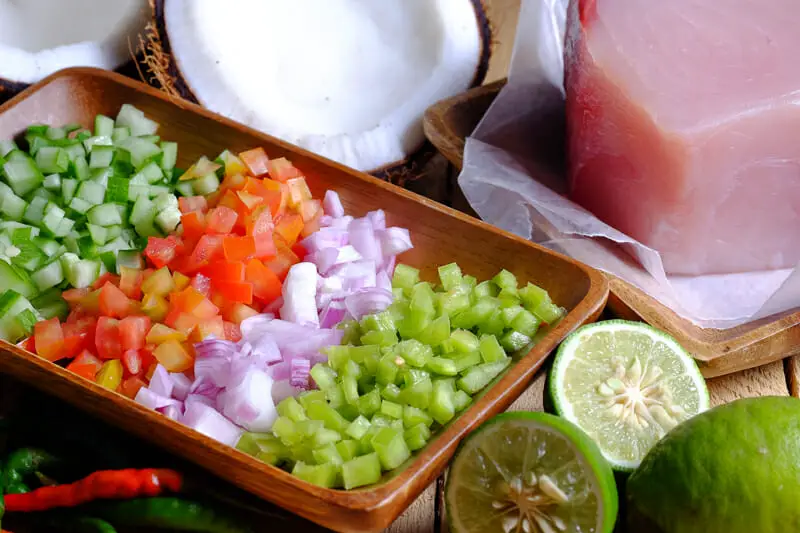
Working with fresh mahi mahi should take no effort at all. You can slice through its beautifully white flesh with a butter knife – yes, it’s that smooth.
For this recipe, we suggest that you cut the fish into even cubes about half an inch big. This size makes for perfect spoonfuls of fish along with the vegetables and spices into every bite.
But take heed! You’ll need to cut the pieces uniformly so that all the pieces of fish “cook” perfectly in the same amount of curing time. Uneven cutting leads to smaller cuts flaking apart by the time the bigger chunks come to the right doneness.
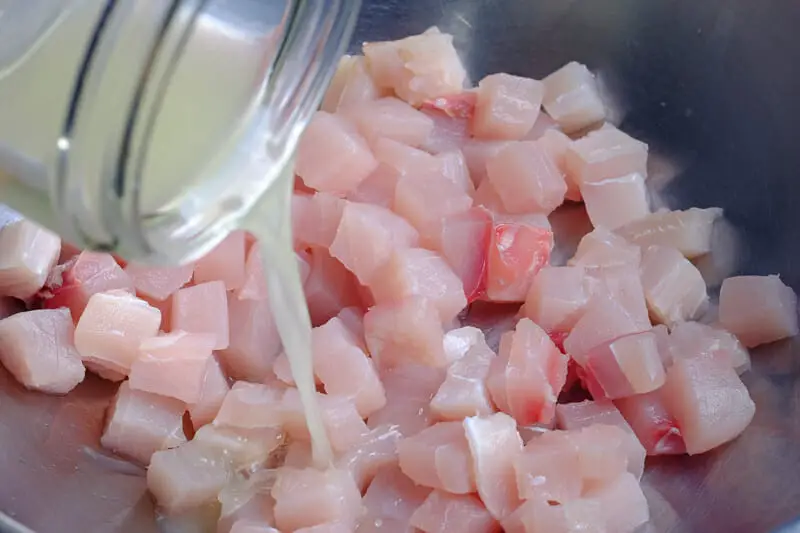
Next up is curing the fish. For an authentic kokoda, you will want to use fresh limes… and lots of them. You’ll want enough lime juice to get your fish fully covered to make sure they marinate evenly. However, if you don’t have limes, you can use other types of acidic solutions like lemons, grapefruit, tamarind or even white vinegar. The acid of choice isn’t used as much for adding flavor but rather to get the fish into a denatured, “pseudo-cooked” state.
As a warning, this denatured state does not guarantee your fish free from any harmful parasites like cooking with heat does, which is why you should use only the freshest of fish for ceviche-style dishes.
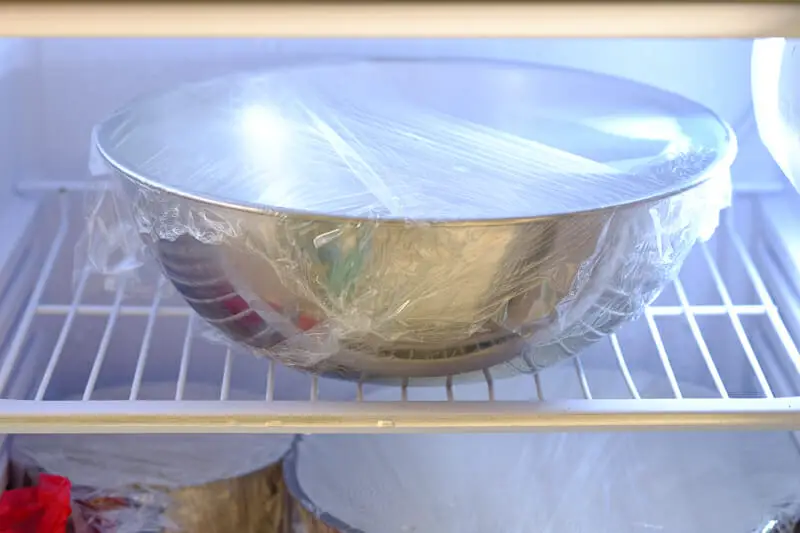
As a warning, this denatured state does not guarantee your fish free from any harmful parasites like cooking with heat does, which is why you should use only the freshest of fish for ceviche-style dishes.
We left our mahi mahi chunks to soak in the lime juice until they turned fully opaque. This may take anywhere from 3-5 hours, depending on the size of the fish cuts. It’s best to use a well-covered bowl inside your refrigerator to avoid any possibility of bacterial growth and corresponding food poisoning that may occur if the fish is left to cure at room temperature.
Shortly before serving, start working on the vegetables and aromatics. There are no strict rules here either, but don’t cut them too early or they’ll dry out. Add in tomatoes, cucumbers, shallots, cilantro and some peppers for heat according to how spicy you like it.
If you’re serving a Fijian native, you may want to stick with the ingredients in this recipe so as not to ruin their expectations, but otherwise, you have full liberty to add anything you’d like to make your Kokoda more visually and texturally more interesting.
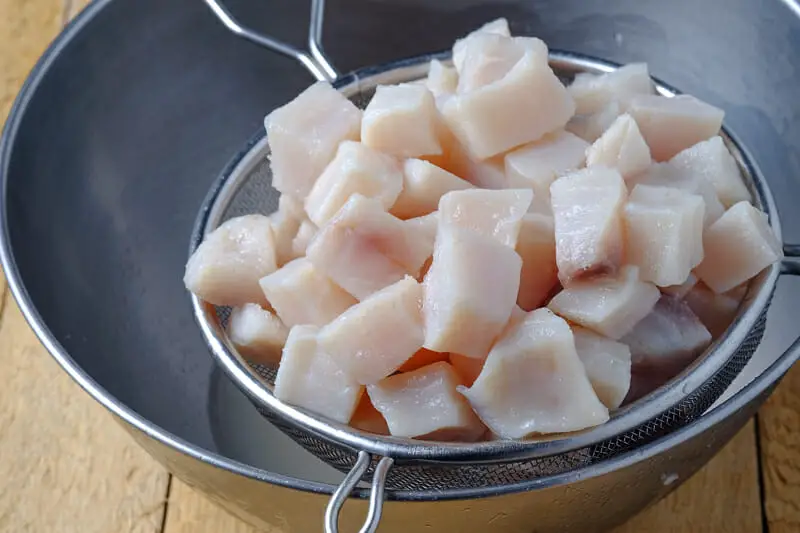
After you’ve chopped your veggies through, drain the acidic juices in the bowl containing your fish. You don’t want to ruin that creamy coconut milk by allowing it to turn too runny.
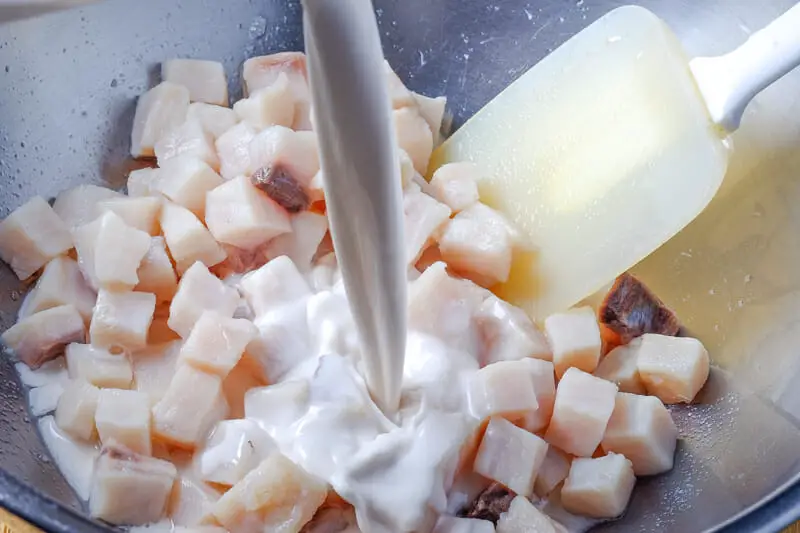
Finally, combine the fish, chopped vegetables, coconut milk, spices, and seasoning into the final serving bowl. Give it a good toss to marry all those flavors, add your final touch of fresh herbs, and if you’re in the mood for more heat, go ahead and add some additional chilis.

If you feel like going the whole nine yards and really emulating that resort feel, you could serve your kokoda in an empty coconut shell with a few slices of lime on the side.
OUR TAKE ON THE RECIPE
As we started researching how to properly prepare a traditional Kokoda, we were a bit put off by the fact that most recipes called for overnight denaturing of the fish. In the spirit of quick preparation, we were drawn to a recipe that only called for 2 hours of curing, which is why we’ve used it as our reference while we made some of our own adjustments.
Lucky enough to have fresh mahi mahi from our local community market, we decided to prepare this dish as near to authentic as we could, but don’t let the unavailability of any specific type of fish keep you from experiencing this Fijian classic. You could definitely work in a substitute of any firm-fleshed seawater fish like grouper, bass, sole, or flounder. As we mentioned earlier, we’d suggest staying away from oily fish such as sardines, mackerel, tuna or jack. Freshwater catch such as trout or catfish won’t work either because of their muddy flavor.
As long as you are discerning in your choice of ingredients, it’s almost impossible to mess up a kokoda. We loved the suggestions on the source recipe we used, but decided to make some changes according to our own tastes.
We personally find the pungency of red onions too much. We knew that cutting down on the amount called for in the original recipe would result in a considerable loss of flavor, so we decided to go instead with shallots, which have a natural sweetness and less pungent taste.
We love the refreshing nature kokoda and wanted to accentuate it. The addition of some bell pepper tidbits for crunch, juiciness, and subtle smoky pepper flavor just made it more fun to eat and while the cilantro does add a final touch of freshness. If you’re not keen on cilantro – or if you’re simply having a hard time finding cilantro in the market – parsley is also an option.
Striking the right balance between the acidity from the limes and the richness of the coconut milk can be tricky, so it’s worth serving your final product with a wedge or two of lime, just in case your diners prefer a touch more zing.
Finally, we did use fish sauce (on Amazon) in place of salt for the final seasoning and to add another layer of flavor. Honestly, the coconut milk, chili, lime, and cilantro may have subconsciously reminded us of Thai food for this specific choice.
Despite our modifications, we think we’ve kept this dish firmly Fijian, and we loved it as such.
Kana Mai!

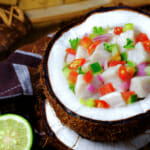
Kokoda: Fijian Coconut Milk Ceviche
- Total Time: 3 hours 15 minutes
Ingredients
- 1 lb fresh Mahi Mahi fillet, cubed
- 4 limes, juiced
- 2 lemons, juiced (1 cup of citrus juice, or enough to submerge)
- 1 cup coconut milk
- 2 medium-sized shallots, finely diced
- 1/2 medium red onion, finely diced
- 1 medium sized green bell peppers, finely diced
- 1 Persian cucumbers, finely diced
- 3 long red chilis, finely diced
- 2 tablespoons parsley, finely diced
- 2 Roma tomatoes, finely diced
Instructions
- Place your cubed Mahi Mahi in a large mixing bowl, then pour the mixed citrus juice over top until the fish is submerged
- Cover the bowl with plastic wrap, then place into the fridge for at least 2 hours
- After at least 2 hours (or more), the fish filet should be opaque and ready to go. Drain the excess liquid.
- Pour the coconut milk over the bowl
- Add your chopped shallots, red onion, green bell pepper, cucumber, chilis, tomatoes and parsley and mix everything well
Serve your kokoda cold either in small bowls or in lettuce cups. Enjoy!
- Prep Time: 15 min
- Cook Time: 3 hours
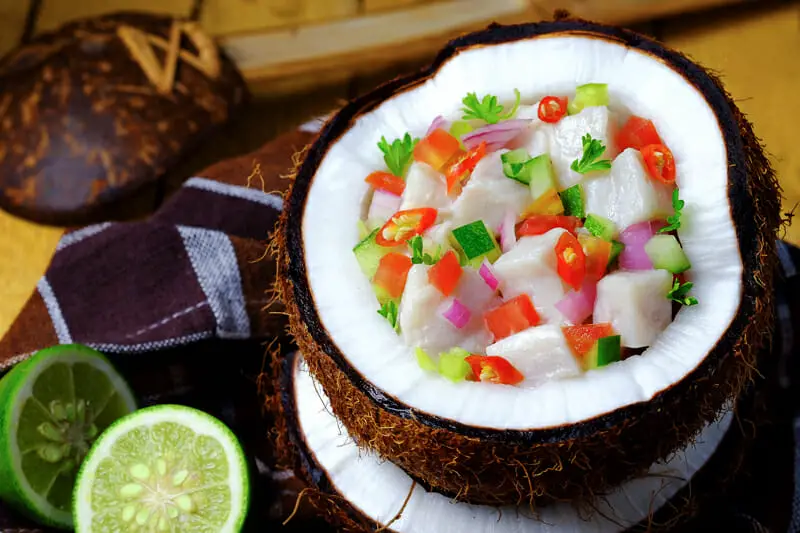

Fresh ginger & cilantro. So good
I first had kododa whilst on a dive trip to Fiji. I was already a ceviche fiend, and this was just next level. Made this as written last night, and really was the hit of the night. Thank you for this easy, delicious recipe!